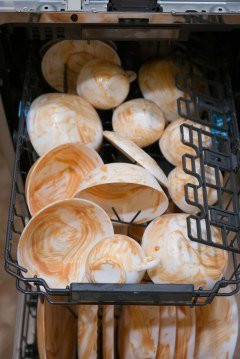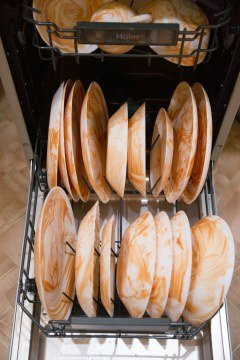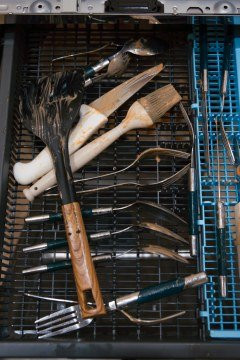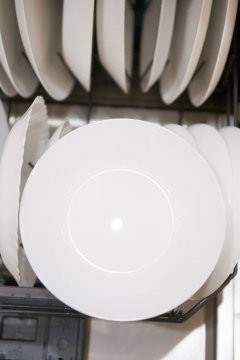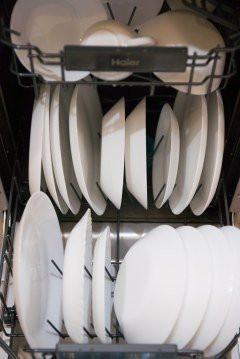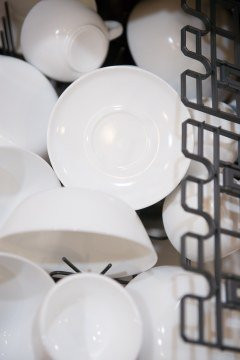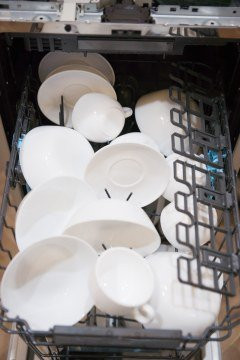We are pleased to present the narrow, fully integrated Haier HDWE11-396RU dishwasher. Inside the device there are two baskets for dishes and a separate basket for cutlery. The model is equipped with a three-level water spray system, 8 washing programs and 6 additional functions. Among these functions are automatic door opening at the end of the cycle and a three-color operation indicator, displayed in the form of a beam on the floor.
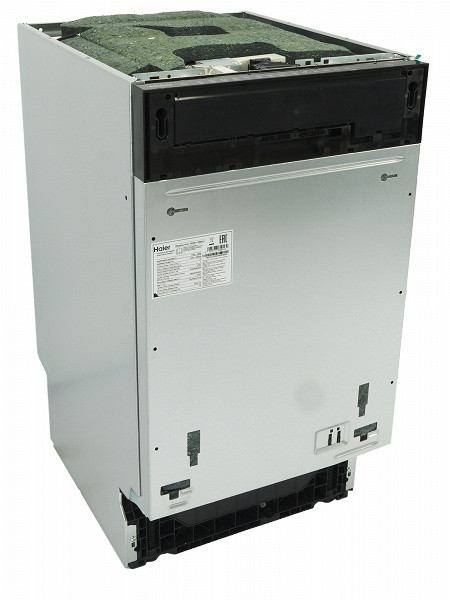
We conducted a series of mandatory practical tests, based on which we determined the effectiveness and ease of interaction with the device.
Characteristics
| Manufacturer | Haier |
|---|---|
| Model | HDWE11-396RU |
| Type | built-in dishwasher |
| Country of Origin | China |
| Guarantee | 1 year + 12 months when registering in the branded application |
| Life time* | 7 years |
| Embedding type | fully |
| Loading | 11 sets |
| Number of shelves | 3 |
| Cutlery shelf | There is |
| Number of washing programs | 8 |
| Leak protection | Yes |
| AquaStop | There is |
| Energy efficiency | A |
| Energy consumption per year | 286 kWh |
| Average energy consumption per cycle | 1.0 kW h |
| Power consumption in off mode | 0.5 W |
| Power consumption in standby mode | 2.5 W |
| Average water consumption per year | 2800 l |
| Drying class | A |
| Standard wash cycle | Eco |
| Standard cycle duration | 298 minutes |
| Noise level | 45 dB |
| Connection power | 1720-2050 W |
| Net weight | 34 kg |
| Dimensions for installation (W×H×D) | 45×88×58 cm |
| Length of network cable | 1.5 m |
* Contrary to popular belief, this is not a period after which the device will necessarily break down. However, after this period, the manufacturer ceases to bear any responsibility for its functionality and has the right to refuse to repair it, even for a fee.
Equipment
Haier HDWE11-396RU is packed in a strong package consisting of foam and cardboard, wrapped in thick polyethylene. On one side of the package there is a sticker with brief information about the model and manufacturer, and on the cardboard cover there are shipping symbols.
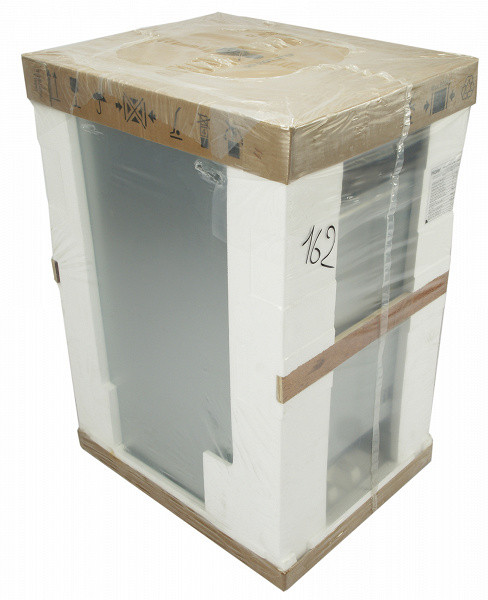
In addition to the machine itself, the delivery set includes:
- a plastic holder for the drain hose
- an inlet hose with an Aquastop valve
- a pair of mounting brackets for embedding
- a pair of brackets for the base recess for the feet
- a funnel for salt
- a set of screws
- a moisture-proof film for furniture
- installation and use instructions
At first sight
From the outside, Haier HDWE11-396RU looks like most other fully integrated dishwashers. We did not expect any unusual design solutions, since after installation the device will be completely hidden behind the facades of the kitchen set.
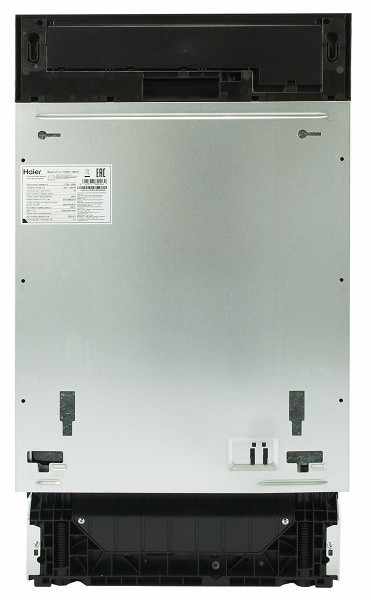
The upper part of the machine is covered with a layer of sound insulation. On the front side there are only openings for hanging the facade and a niche handle that allows you to open the device before installing it.

As with any fully integrated dishwasher, the control panel is located on the edge of the door and is completely hidden when the door is closed.
The rear wall, also equipped with a sound-insulating gasket, houses a non-removable corrugated drain hose and a 145 cm long electrical cable.

The complete inlet hose, equipped with the AquaStop system, is connected to the plastic water outlet at the bottom of the rear panel.

At the bottom of the stainless steel tank is an impeller, also known as a sprinkler. Underneath it is a filter with a metal mesh, which can be removed for cleaning by turning the plastic mesh plug. Next to the filter opening is a screw cap, under which is located a container for the water softener and a neck for filling with salt.
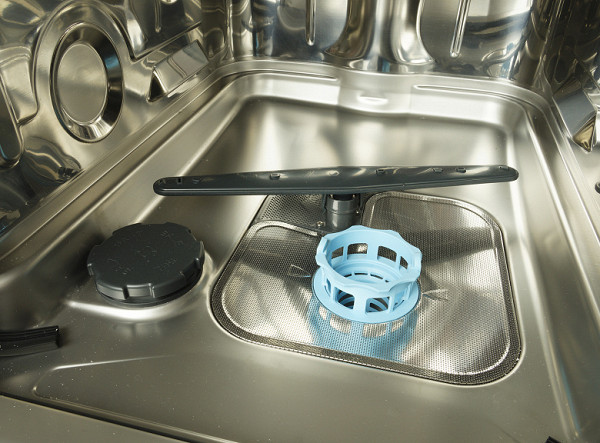
The second sprinkler is attached to the middle basket and extends with it. Both impellers are straight and are rotated by the flow of water coming out of holes located at different angles.
The third, slightly curved impeller is located on the ceiling of the chamber.
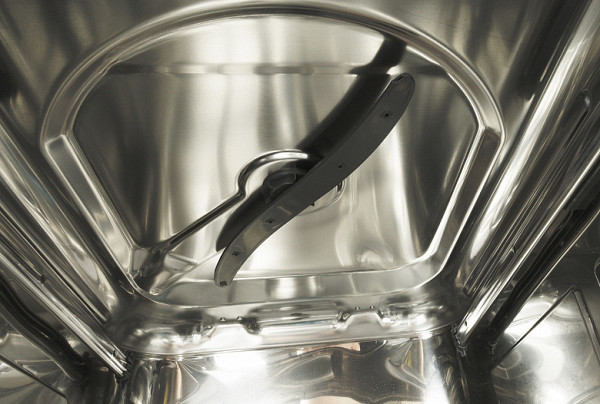
The detergent container on the door is made in a traditional style. The large compartment is designed for tablet or powder detergents, and next to it is a rinse aid container with a lid and a flow regulator.
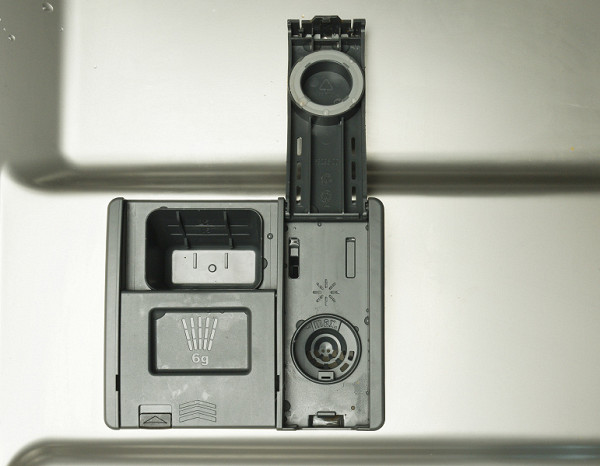
The machine is equipped with three baskets: the lower basket is designed for large dishes such as pans, pots, lids and large plates; the middle basket is suitable for smaller plates, cups, saucers and bowls; and the upper basket is specially designed for compact placement of cutlery.
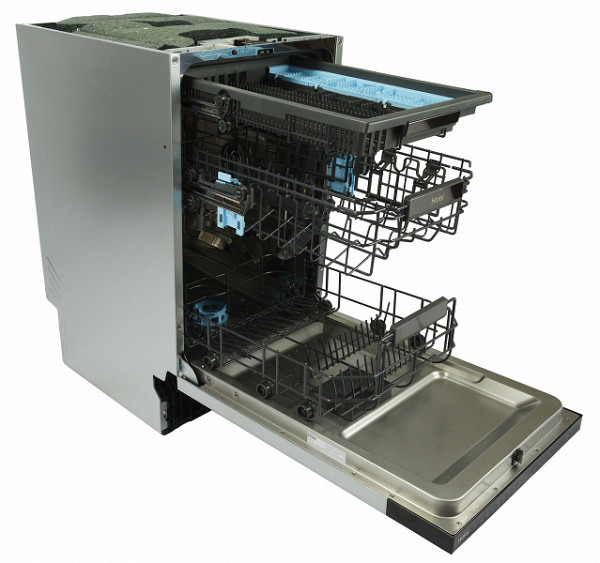
All three baskets are removable. On the front of each basket there are decorative handles with the manufacturer's logo. The lower basket rests on the protrusions in the side walls of the tank, and the middle and upper baskets are installed on retractable telescopic rails with plastic stoppers at the ends.
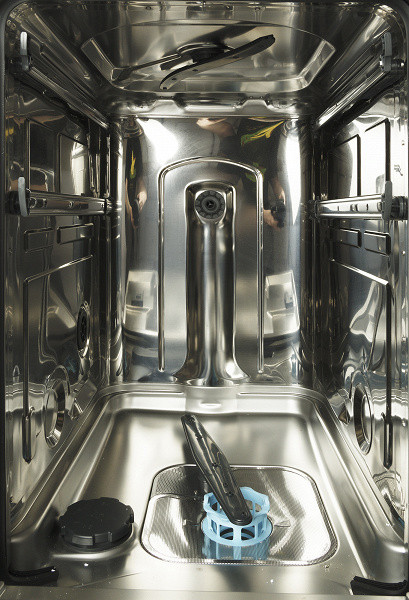
The lower basket has a standard design and rests on eight rollers. The row of holders closest to the door is fixed, and the rear row is folding. This allows you to place a large pot or frying pan in the far half if necessary.
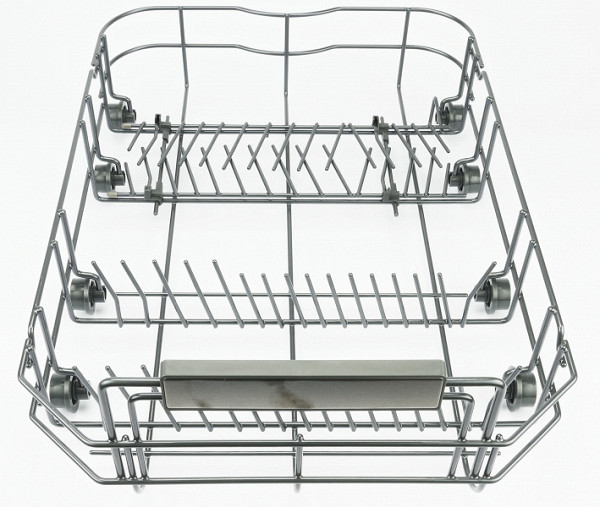
On the right side of the middle basket are folding plastic shelves for small dishes, which can also be used as holders for glasses. In the far left corner of the basket are fixed holders intended for saucers and dessert plates.
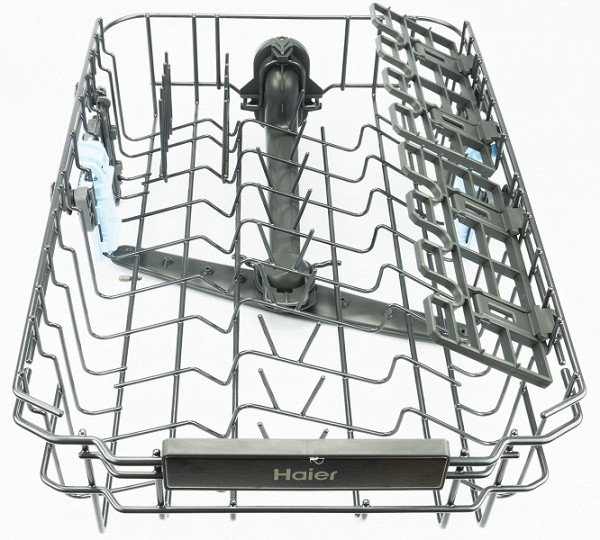
The middle basket has a height adjustment lever, allowing you to place larger containers underneath. However, this will reduce the height of the dishes in the middle basket proportionally.

The upper basket consists of two parts: a frame with rollers on the sides and a plastic tray with dividers for different types of cutlery.
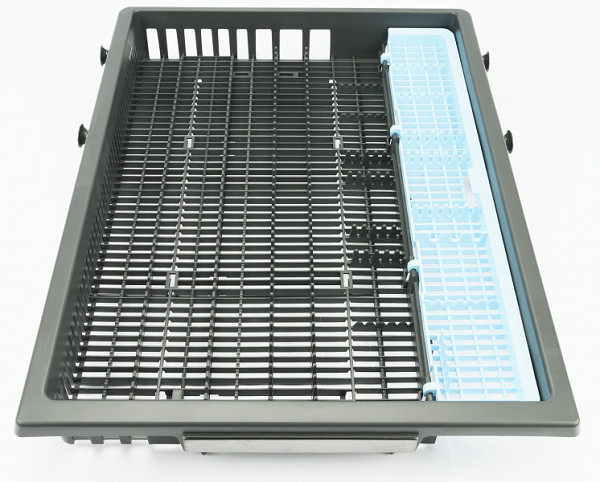
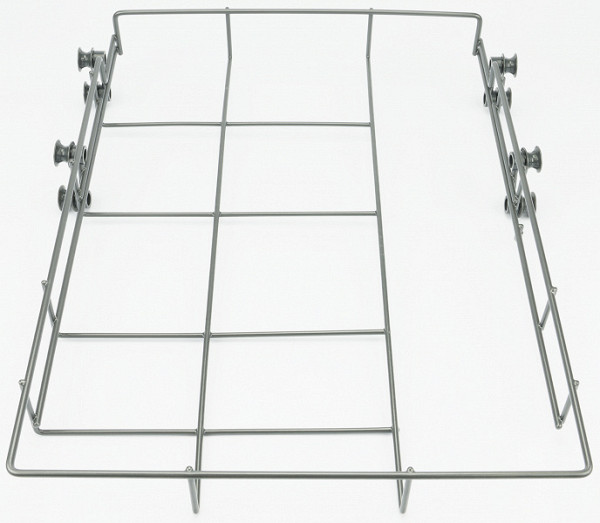
The detachable design of the upper basket is a rather rare solution. We found that it can be convenient for removing the entire plastic cutlery tray from the dishwasher and disassembling it elsewhere.
The door and baskets operate smoothly and quietly, without rattling or loud noises.
Instructions
The user manual is presented as an A5 brochure, in Russian and Kazakh. Almost half of the text is taken up by detailed instructions for installation and connection, accompanied by many detailed drawings and diagrams that illustrate all stages of installing the device — from unpacking to the first launch.
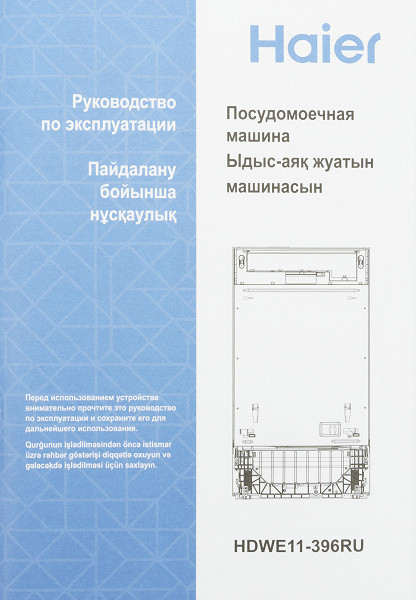
The second half of the brochure is devoted to the operating instructions. This section contains detailed information about the machine's structure, control of the device, as well as its operation and maintenance. However, some control nuances related to additional functions remained unclear.

The last pages are reserved for a table with recommendations for self-elimination of possible malfunctions and a warranty card.
Management
The touch control panel is a bit scary at first, there are so many buttons on it.

The machine is switched on by the leftmost sensor with a standard pictogram. The following eight sensors are used to select programs:
- Eco: 50°C, for normally soiled dishes. This is the most energy-efficient program, but also the longest.
- Standard: 60°C, for normal soiling. The cycle is twice as short as Eco.
- Intensive: 75°C, for heavily soiled dishes.
- Smart: 45–50°C, suitable for any type of soiling. The machine automatically detects the degree of soiling and the amount of dishes, adjusting the temperature, water consumption, energy consumption and program duration.
- Rinse: 10-minute program without detergent.
- Daily: 59 minutes for light soiling.
- Quick wash: 20 minutes for a quick wash with detergent.
- Smart Plus: 65–75°C, for any level of soiling. The cycle parameters are set by the machine depending on the condition of the dishes.
The programs on the panel are indicated by pictures and numbers without names, so you will have to remember them.
Additional functions:
- Half load
- Disinfection
- Drying
- Automatic door opening
- Delayed start timer from 1 to 24 hours in 1 hour increments
- Control panel lock
There are no instructions for the two functions (disinfection and drying). The automatic door opening function is activated automatically only in the Eco program, and in other programs it can be switched on optionally before the start of the cycle. In the Rinse mode, the automatic door opening function does not work.
The display shows the following indicators:
- Tablet presence
- No water
- No rinse aid
- No salt
The control panel ends with a button for starting and canceling the program.
After turning on and holding the Half Load button, the additional settings menu opens, where you can set the parameters for water hardness, rinse aid, turn off the sound signals and configure the use of detergent. In this menu, you can also set the device's memory so that the last used program is automatically launched when turned on.

When you select a program, the display shows the duration of the cycle; after starting, it shows a countdown.
Exploitation
The dishwasher is connected in the same way as most similar models: the corrugated drain hose is connected to the sewer, and the inlet hose with the AquaStop valve is connected to the water supply system.
The complete instructions provide all the information you need to install the appliance and attach the decorative front panel to the door. After installing the front panel, you need to adjust the locking springs using the screws at the bottom of the front panel. It is also important to ensure that the socket to which the appliance will be connected is grounded.
The connected appliance should be leveled horizontally using the front legs. The slope should not exceed 2° in any direction. After that, you can install the decorative plinth covering the bottom of the machine.
Before starting operation, you need to find out the hardness of the water in the water supply and, if necessary, add salt to the softener and adjust its consumption in accordance with the parameters obtained.
If you plan to use combined detergents in tablets or capsules, you should activate the «3 in 1» function in the settings to turn off the rinse aid supply.
During testing, Haier HDWE11-396RU proved to be reliable: all functions and programs worked without failures, as stated in the documentation. The set of programs is suitable for any usage scenarios. The interior space is ergonomic and conveniently organized.
The operation of the dishwasher is accompanied by a three-color indicator on the floor: blue — washing, green — rinsing, red — drying. At the end of the cycle, the door automatically opens to allow natural drying of the dishes and the release of moist air.
In the event of a power failure, the machine remembers the current stage and continues to work from this point after power is restored.
Care
Maintenance of the appliance includes regularly refilling the salt and rinse aid reservoirs. The filter should be cleaned periodically: it is easy to remove, disassemble and reassemble. It is also recommended to periodically remove the lower and middle spray arms, wash them and, if necessary, clean the holes with something sharp, such as a toothpick. To clean the interior, it is better to use a soft, damp, lint-free cloth and, if necessary, use cleaning and descaling agents.
Our measurements
Information on energy consumption, water consumption and cycle duration is provided in the documentation. We measured the actual values for some programs and compared them with the data provided by the manufacturer.
| Program | Energy consumption, kW h | Water consumption, l | Duration, min. | |||
|---|---|---|---|---|---|---|
| declared | actual | declared | actual | declared | actual | |
| Eco | 1.00 | 0.741 | 10.0 | 10.0 | 298 | 298 (143)* |
| Standard | 1.60 | 1,536 | 17.6 | 17.0 | 129 | 129 |
| Intensive | 1.80 | 1,620 | 21.0 | 21.0 | 146 | 146 |
| Smart | 1.10-1.20 | 14.2 | 110 | |||
| Rinsing | 0.01 | 7.4 | 10 | |||
| Daily | 0.90 | 0.792 | 10.8 | 11.0 | 59 | 59 |
| Quick wash | 0.30 | 10.8 | 20 | |||
| Smart Plus | 1.50-1.60 | 14.2 | 160 |
The passport states that all values, except for the Eco program, are approximate and may change depending on the water pressure and temperature, voltage in the electrical network and the degree of contamination of the dishes. In our case, on the contrary: it was the Eco program that turned out to be problematic. Washing in this mode ended at the 143rd minute, the door opened slightly, but the display continued to count down from 298 minutes. The rest of the time, the machine simply counted down the minutes, without an active process inside. Despite this, the dishes were washed quickly and efficiently.
The noise of the machine during operation is moderate and slightly exceeds the declared passport data — on average, we recorded 45-50 dBA. It should be taken into account that the measurements were carried out without embedding the machine in the kitchen unit, so after installation, the noise level may be lower.
The maximum power consumption during testing was 1899 W. In standby mode, the dishwasher consumes 0.4 W.
Practice tests
Standard program and "artificial dirt"
For the first test, we used our specially prepared mixture of proteins, fats and carbohydrates to create the most unfavourable conditions for the machine.
We generously applied the sticky mixture to the dishes and left them to dry for 24 hours. Large plates were placed in the bottom basket, bowls, cups and saucers in the middle, and cutlery, several knives, a large spatula and a brush used to apply the mixture were placed in the top basket. The dishes were deliberately placed carelessly to make the task more difficult for the dishwasher.
For this test we selected the Standard program, and it performed extremely well: we did not find the slightest trace of dirt on the contents of the baskets.
Everything was washed perfectly, sparkled and creaked. After cooling down, we took the dishes out almost dry. A small amount of moisture was found only on the cutlery in the upper basket.
Result: excellent
Eco program and dried ketchup
The next time we used glass jars: a couple of three-liter ones and one two-liter one. We pretty much stained the inside of the containers and left them like that to dry for a day.
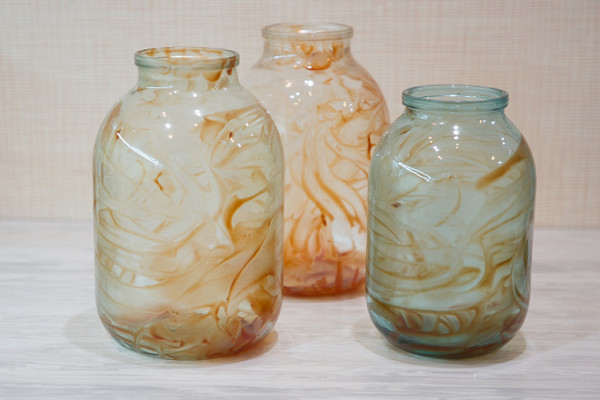
Then we placed it in the lower basket and turned on the Eco program.

After 143 minutes, the machine finished its work, the door opened, and we immediately checked the result. The dried tomato mixture was completely removed, no traces of our dough remained. All the jars were dry and without any drips, only a few drops remained on the baskets.

Result: excellent
Wine glasses
We smeared four thin glass goblets with thick lipstick and stained them with red wine, mostly on the inside and a little on the outside, in the area of the stems. Then we left them to dry for a day.

We were unable to place large glasses in the middle basket as they should be, with the legs fixed in special recesses. Only those specimens that are no higher than 20 cm fit there perfectly.
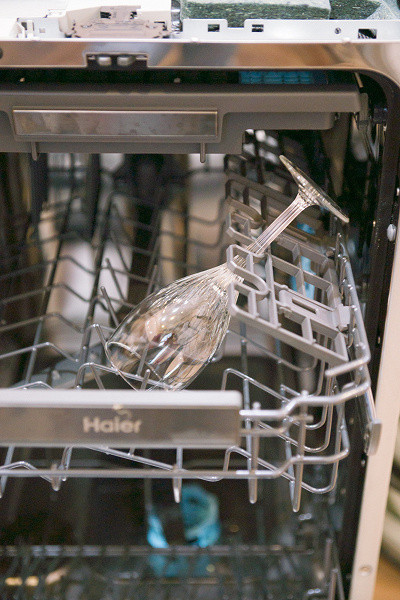
The dirty glasses were 5 cm higher, so I had to simply lean the legs on the shelf, and place the fourth glass horizontally.
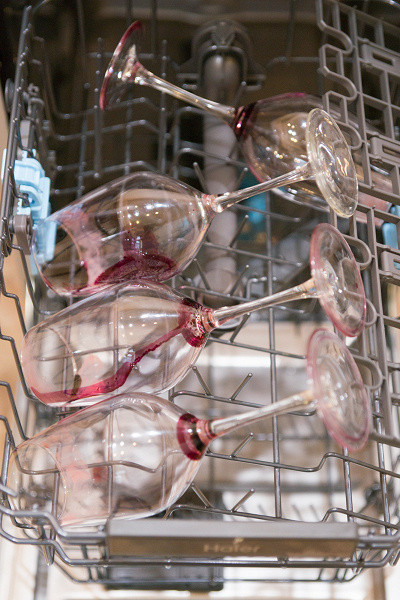
This model does not have a special program designed for glass, so we launched the Daily program at our discretion.
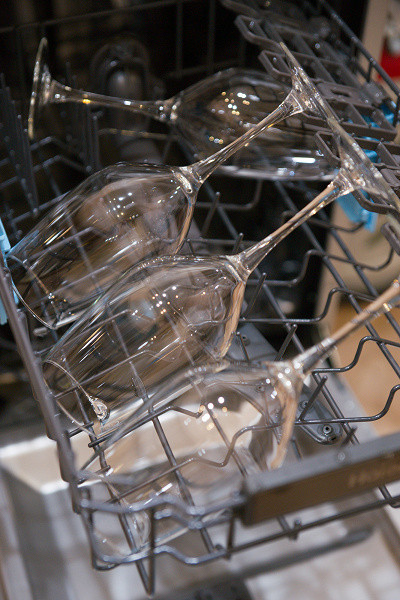
Despite the difficulties with the arrangement, at the end of the cycle we took out absolutely dry, clean glasses from the machine. Both washing and drying were five plus.

Result: excellent
Intensive washing and heavily soiled dishes
To test the intensive cleaning program, we used a glass baking dish in which fatty meat with sauce was baked. The food remains were fried for an additional 15 minutes to form a durable crust. Then the dish was left for a day before washing.

We placed it in the lower basket and started the machine in the Intensive Wash mode.

The form was completely washed, no traces remained, the glass was a little wet.
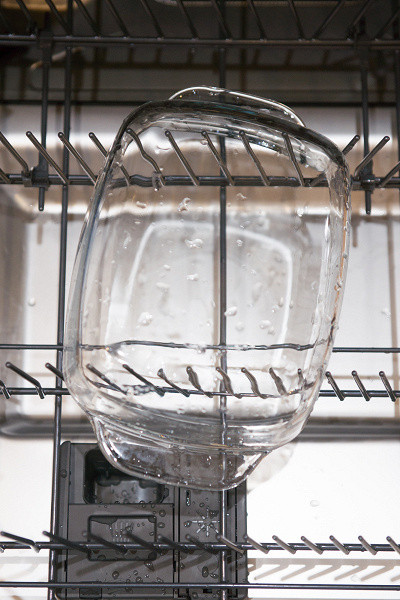
For some reason, the door did not open automatically at the end of the cycle. We were unable to find out the reason, but we were so satisfied with the result that we did not reduce the rating for this.
Result: excellent
conclusions
The Haier HDWE11-396RU dishwasher is a high-tech model with many modes for any needs, ergonomic and spacious interior space and convenient controls. However, the instructions could have been more detailed. Some additional functions remained unappreciated due to the lack of their description in the accompanying documentation.
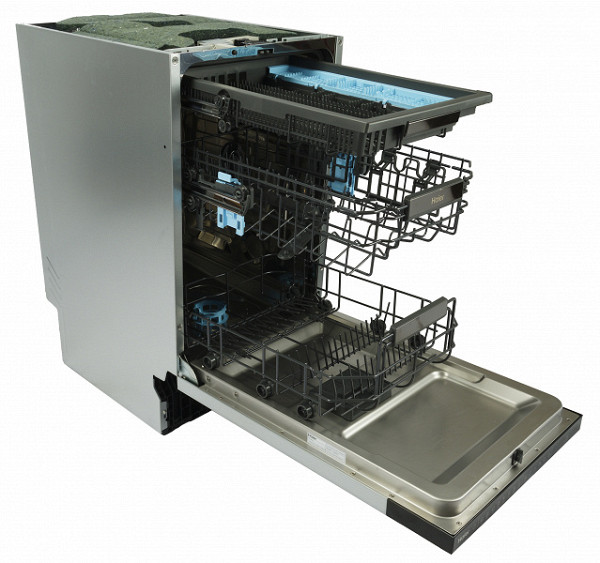
The dishwasher is highly efficient: it easily handles ordinary dirt, gently washes fragile dishes and perfectly removes stubborn dirt. For ease of use, there is a three-color operation indicator in the form of a light spot on the floor and an automatic door opening system at the end of the cycle. The safety of the device is ensured by AquaStop leak protection.
Pros:
- spacious interior with three baskets
- three-level water spray
- high efficiency
- wide choice of built-in programs
- automatic door opening
- three-color floor indicator of operation
Cons:
- some points in the documentation raise questions

